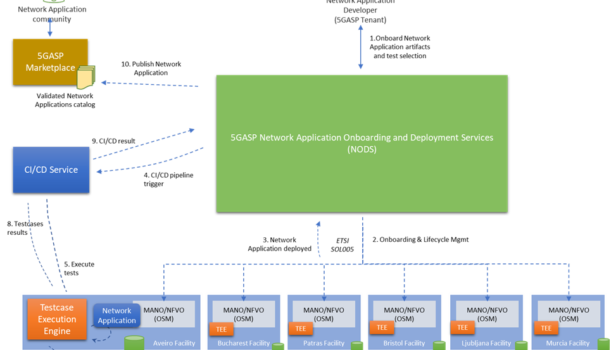The 5GASP project envisaged supporting a multi-site CI/CD DevOps cycle for Network Applications enabled by reproducible network service deployments. For this purpose, it supports the management of multiple NFVOs, spanning through multiple geographical areas across Europe, to orchestrate, oversee and validate the employed Network Application. Also, it introduces a triplet entity (Network Application artifacts, network slice, test artifacts) as the input for the aforementioned process, already referred to in previous posts. The models describing the triplet align with widely known industry standards, i.e. TM Forum, offering each triplet’s entity as a Service. The architectural component that is in charge of the above processes is the 5GASP Network Application Onboarding and Deployment Services (NODS), as seen in Figure 1.

5GASP NODS is based on the open-source platform OpenSlice, which was further extended and supported by 5GASP consortium members through the project’s duration to meet its needs. Recently, OpenSlice debuted as the first Software Development Group (SDG) backed by the European Telecommunications Standards Institute (ETSI), having its kick-off meeting at Barcelona in October.
OpenSlice, and recently addressed under the name of ETSI SDG OSL, is an open-source, service-based Operations Support System (OSS) prototype for delivering Network Slice as a Service (NSaaS) and more widely, Network as a Service (NaaS) following specifications from main Standards Development Organizations (SDOs), including ETSI, TM Forum, GSMA, and 3GPP. Following the Anything-as-a-Service (XaaS) paradigm, strong attention has been drawn to the NSaaS and NaaS model, in particular. NaaS is more of a business- oriented concept than a technological one, allowing on one side to automatically map service demands from a customer to functionalities, topology, policies, and parameters of a network slice, as well as to provide component-based and auto-configured network functionalities for operators to design and launch network services in a more convenient manner. Examples of NaaS models include the Generic Slice Template (GST) as defined by GSMA [1] or the recent efforts of the Open Gateway initiative[2].
The first “code seeds” of OpenSlice started back in 2018 with the European project 5GinFIRE. However, it only became OpenSlice later on, when it was further developed and matured in the context of EU funded project 5G-VINNI (now completed). Since then, it has been adopted and received contributions from several other research projects, including 5GASP. With its recent establishment as an ETSI SDG, OpenSlice aims to complement future network activities at ETSI (NFV, ZSM, OSM, TFS) by enabling prototyping, experimentation and validation of complex telco use cases. Within OSL, it is expected that early and regular feedback to standardization groups will contribute to higher quality standards and faster time to market.
To end up, several of the above concepts were also used and validated throughout 5GASP’s pipelines, further boosting OpenSlice’s confidence to achieve its ambitious future goals.
[1] https://www.gsma.com/newsroom/wp-content/uploads/NG.116-v8.0-1.pdf
[2] https://www.gsma.com/futurenetworks/gsma-open-gateway/


